
Coral Nursery Program benefits reef area
HOMESTEAD, Fla. — Inside his University of Miami office, marine science professor Dan DiResta ponders over the condition of coral reefs in Biscayne National Park. Their conservation has been the subject of his research for decades. He leans forward in his chair.
“When I started working on coral reefs in the park, there was about 35 percent live coral cover on the reef,” he said. “Now it’s down to about 7 percent.”
Over-fishing, climate change, pollution, hurricanes…. The factors contributing to their demise in Biscayne National Park run the gamut.
| Click on the video to see a slideshow about the Biscayne coral nursery program narrated by writer Farah Dosani. |
Combating these broad forces is intimidating to say the least.
“Restoring reefs that are affected by these stressors is not going to do anything, because the stressor is still there,” said DiResta.
So he and Biscayne Chief Scientist Richard Curry decided to focus on a more localized factor.
Biscayne’s Coral Nursery Program formed out of an effort to rescue the damaged corals and restore the reefs that have been grounded by boats.
| Coral Nursery Club volunteers snorkel and survey patch reefs (Photos courtesy of Thomas Strom). Below, volunteers remove coral fragments from the nursery to clean algae and monitor growth. Next, coral reefs such as this one are the centers of biodiversity in marine environments. Next, fragments of broken-off coral are epoxied to PVC pipes before being placed in the field nursery. Last, fragments in the field nursery. | 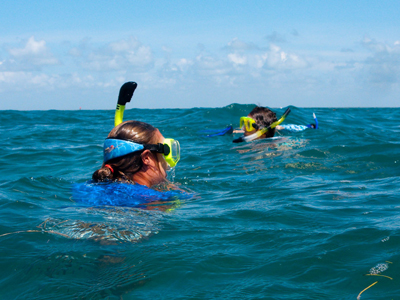 |
Each year, watercrafts run over reefs in the shallow waters of the park’s eastern border. The groundings damage and break the corals into pieces. Although the larger fragments can be stabilized and re-grown in place, the small ones tend to be carried by waves, often falling into crack and dying.
The volunteer-based initiative works to collect the pieces broken off from groundings. They are re-grown in a field nursery underwater with the hopes of transplanting them back to the reef.
Curry and DiResta first launched a version of the project in 1992 after Hurricane Andrew devastated South Florida and Biscayne National Park.
They refined the project into a rescue effort and nursery for corals grounded by boats in the late 1990s. The approach was novel for the time.
Before then, reef restoration biologists would put cement or limestone to stabilize the damaged coral and retrieve corals off neighboring reefs to replace it.
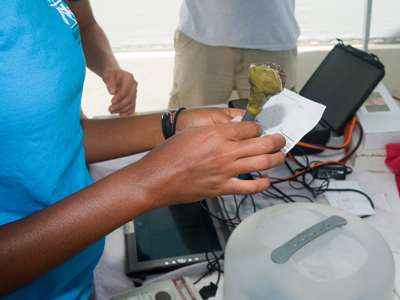 “So you’re trying to restore this reef, while destroying this reef,” explained DiResta. He and Curry chose a different approach.
“So you’re trying to restore this reef, while destroying this reef,” explained DiResta. He and Curry chose a different approach.
Like a tree nursery on land, the underwater field nursery cultivates corals to re-landscape damaged areas.
Karlisa Callwood and other volunteers play a vital role at the nursery and sustain the project.
She first helped out with the program as a University of Miami marine science student in 2000 and is currently a graduate student at UM’s Rosenstiel School of Marine and Atmospheric Science.
“When you’re in class, you’re no getting much real world experience,” said Callwood. “I got to go out every Saturday and actually utilize the things I learned in class every week and got to see what it was really like to be a marine scientist.”
At first, the operation relied primarily on student volunteers recruited by DiResta and the marine science program at the University of Miami.
“We calculated about 800 volunteer hours of man time,” said DiResta. “We couldn’t do it without them!”
However, more and more the nursery has been attracting volunteers from the community to sustain the operation.
Callwood became president of the Coral Nursery Club, which formed earlier this year.
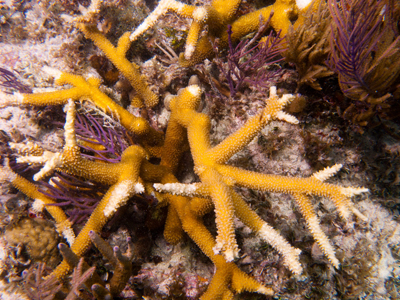 “Richard Curry, who’s the main person at the park that oversees [the program], really wants to make sure the coral nursery carries on,” she said. “He’s nearing retirement, [and] it’s a project that he dedicated 15 years to. Because of that, he wanted to make sure it was something that stayed and carried on even if he left.”
“Richard Curry, who’s the main person at the park that oversees [the program], really wants to make sure the coral nursery carries on,” she said. “He’s nearing retirement, [and] it’s a project that he dedicated 15 years to. Because of that, he wanted to make sure it was something that stayed and carried on even if he left.”
The club is assisting the attempt to shift the Coral Nursery Program from a more park-based operation to a volunteer-run group. Part of this is by helping to organize the outings and train individuals. It has attracted 130 members to its e-mail list, although 10 to 14 volunteers usually attend each outing.
“It’s first-hand tangible, outward, visible conservation,” said volunteer Chris Jehle. “Just that hands-on feeling is a good drawing point to the program.”
The volunteers include students, accountants, teachers, graphic designers and photographers—to name a few.
“We always have a good mix of people out there and they range in age from high school students all the way up,” said Callwood.
The club meets on Saturdays and works on different steps of the system.
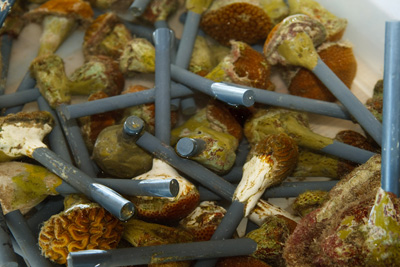 Curry, DiResta and volunteers first collect the broken-off coral from the grounding sites.
Curry, DiResta and volunteers first collect the broken-off coral from the grounding sites.
Over the years, they have generated a map of Biscayne’s 4,000 or more patch reefs and periodically survey the ones that are more shallow and susceptible to damage.
About 20 groundings are reported in Biscayne National Park each year. But, DiResta says the park believes that this only represents about 5 percent of the actual groundings that occur.
Accessing fragments from reported groundings though is problematic at times. Boaters are charged under the National Park System Resource Protection Act and can be fined or go to court. The broken coral is off limits until the case is settled.
“Just as you would not handle a bloody weapon at a murder scene, the coral may have information, perhaps bottom paint from the offending boat, that could be used to prosecute the case,” explained Biscayne Park Ranger Gary Bremen.
Biscayne’s Damage and Recovery Program takes procedures to save the coral, like turning broken pieces over so they can receive sunlight. But, the Coral Nursery Club says that without immediate access to the fragments, the corals sometimes die during the investigation or proceedings in court.
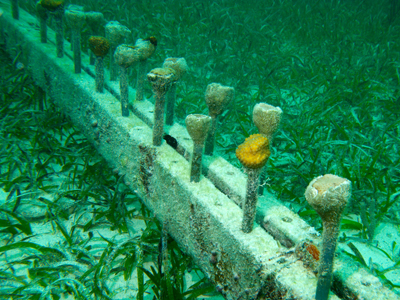 Once fragments are retrieved, volunteers take them to the University of Miami Experimental Hatchery on the Virginia Key where they are stabilized and prepared for the nursery.
Once fragments are retrieved, volunteers take them to the University of Miami Experimental Hatchery on the Virginia Key where they are stabilized and prepared for the nursery.
They cut the corals into one- to two-inch pieces, mount them on a PVC pipe with epoxy and embed an electronic tag to identify and monitor their growth. The final product looks like a coral popsicle—or “coralsicle” as volunteers like to call them.
Adams Key was chosen as the site for the nursery. The “coralsicles” protrude out of the rows of wooden posts run transverse on the pilings of the docks underneath the shore. The tidal current keeps the water moving and maintains optimal conditions for the coral.
Every six months, volunteers resurface the coral to scrape off algae and document their growth. Today, about 400 corals grow in the nursery.
However, the Biscayne’s Coral Nursery Program has yet to transplant any of the corals to the reefs. They must grow to five or six inches before reaching reproductive maturity and leaving the nursery. Their slow growth rate of half an inch per year prolongs the process.
“They’ve only come in, they haven’t gone out yet,” said DiResta.
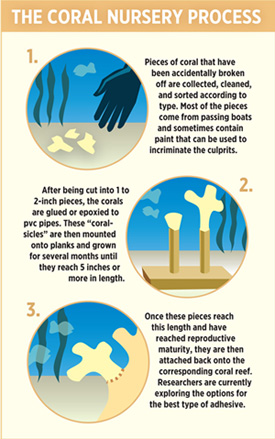 Researchers are also trying to find the right approach to re-attaching the coral to reefs. Circulating possibilities include the use of cement, epoxy and screws.
Researchers are also trying to find the right approach to re-attaching the coral to reefs. Circulating possibilities include the use of cement, epoxy and screws.
But, Callwood cautions that these are not environmental solutions.
“Anything we put out there, we want to make sure that it’s something already part of the environment or…something [that] will not impact the environment and maybe overtime fade away on its own,” she said. “With concrete, that doesn’t happen.”
Although the project’s ultimate success can be judged once the corals are restored to the reefs, the program believes the fact that coral fragments are growing is a testament to progress.
Volunteers see their localized efforts to conserve these ‘rainforests of the sea’ as a step in the right direction.
“We’re only right now looking at one aspect when they’re actually a myriad of things going on,” said Callwood. “But, we can only do what we can in the time that we’re given, you know?”
If You Go…
- All club field activities and meetings take place on Saturdays. The boat leaves the park’s Convoy Point headquarters at 9:30 a.m. returns around 3 p.m.
- To get involved in the Coral Nursery Club, contact Richard Curry at 786-335-3633 or e-mail the club at crossettcoral@gmail.com
Information graphic designed and prepared by Bill Gerdts.

Comments are Closed